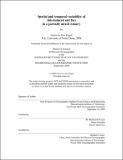| dc.contributor.advisor | W. Rockwell Geyer. | en_US |
| dc.contributor.author | Engel, Patricia Ann | en_US |
| dc.contributor.other | Woods Hole Oceanographic Institution. | en_US |
| dc.date.accessioned | 2010-05-25T19:19:50Z | |
| dc.date.available | 2010-05-25T19:19:50Z | |
| dc.date.copyright | 2009 | en_US |
| dc.date.issued | 2009 | en_US |
| dc.identifier.uri | http://hdl.handle.net/1721.1/54845 | |
| dc.description | Thesis (S. M.)--Joint Program in Oceanography/Applied Ocean Science and Engineering (Massachusetts Institute of Technology, Dept. of Earth, Atmospheric, and Planetary Sciences; and the Woods Hole Oceanographic Institution), 2009. | en_US |
| dc.description | This electronic version was submitted by the student author. The certified thesis is available in the Institute Archives and Special Collections. | en_US |
| dc.description | Cataloged from student submitted PDF version of thesis. | en_US |
| dc.description | Includes bibliographical references (p. 41-43). | en_US |
| dc.description.abstract | Mechanisms for the tidal component of salt flux in the Hudson River estuary are investigated using a 3D numerical model. Variations with river discharge, fortnightly tidal forcing, and along channel variability are explored. Four river discharge conditions were considered: 1200 m3 s-1, 600 m3 s-1, 300 m3 s-1, 150 m3 s-1. Tide-induced residual salt flux was found to be variable along the channel, with locations of counter-gradient flux during both neap and spring tide. The magnitude of tidal salt flux scales with the river flow and has no clear dependence on the spring-neap tidal forcing. The diffusive fraction, ?, has a value of -0.25 to 0.46 in the lower estuary, increasing to -0.23 to 1 near the head of salt. The phase lag between tidal salinity and velocity is analyzed at three cross-sections with: large positive, negative, and weak tidal salt flux. The composite Froude number, G2, is calculated along the channel and indicates nearly ubiquitous supercritical flow for maximum flood and ebb during both neap and spring tides. Subcritical flow occurs during slack water and at geographically locked locations during neap floods. Application of two-layer, frictional hydraulic theory reveals how variations in channel width and depth generate tidal asymmetries in cross-sectional salinity, the key ingredient of tidal salt flux. | en_US |
| dc.description.statementofresponsibility | by Patricia Ann Engel. | en_US |
| dc.format.extent | 45 p. | en_US |
| dc.language.iso | eng | en_US |
| dc.publisher | Massachusetts Institute of Technology | en_US |
| dc.rights | M.I.T. theses are protected by
copyright. They may be viewed from this source for any purpose, but
reproduction or distribution in any format is prohibited without written
permission. See provided URL for inquiries about permission. | en_US |
| dc.rights.uri | http://dspace.mit.edu/handle/1721.1/7582 | en_US |
| dc.subject | Earth, Atmospheric, and Planetary Sciences. | en_US |
| dc.subject | Joint Program in Oceanography/Applied Ocean Science and Engineering. | en_US |
| dc.subject | Woods Hole Oceanographic Institution. | en_US |
| dc.subject.lcsh | Salinity Computer simulation | en_US |
| dc.subject.lcsh | Tides | en_US |
| dc.title | Spatial and temporal variability of tide-induced salt flux in a partially mixed estuary | en_US |
| dc.type | Thesis | en_US |
| dc.description.degree | S.M. | en_US |
| dc.contributor.department | Joint Program in Oceanography/Applied Ocean Science and Engineering | en_US |
| dc.contributor.department | Woods Hole Oceanographic Institution | en_US |
| dc.contributor.department | Massachusetts Institute of Technology. Department of Earth, Atmospheric, and Planetary Sciences | |
| dc.identifier.oclc | 608077664 | en_US |
